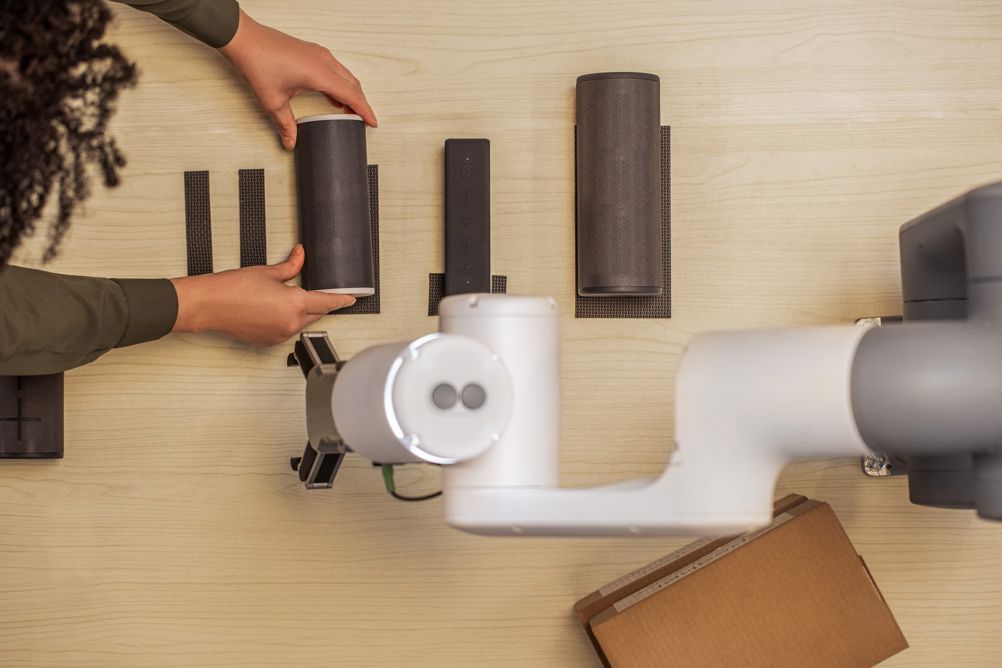For today’s manufacturing companies, cobots offer many benefits that add value at every step of the production process. Their ability to work safely alongside humans, without the need for physical guards, greatly reduces their overall footprint. This makes them ideal for applications where users want to maximise productivity without compromising on safety. Applications can include both continuous and intermittent collaboration, such as final trim and assembly in automotive manufacturing where some human interaction is needed.
Cobots also provide the flexibility to manage the shift towards low-volume/high-mix production, because they can swap between products and be trained to work with new products quickly and easily. With people and robots working side by side, users can benefit from the problem-solving capabilities, insights and adaptability to change of human operators, as well as the tireless precision and tolerance of repetitive tasks provided by robots.
Big potential, small size
The global cobot market was valued at US$1.23 billion in 2022 and is expected to expand at a compound annual growth rate (CAGR) of 32.0 per cent, from 2023 to 2030, according to Grand View Research*. The analyst suggests that a combination of two factors is driving that growth.
First is the penetration of cobots into SMEs as they become more accessible in terms of price and ease of use. While robotic automation technology has evolved to meet the growing demands for high volume industrial production, it has also led to the creation of smaller collaborative robots designed to fit easily into existing production lines, thanks to their flexible mounting options. With their smaller size and reduced reliance on peripheral equipment, collaborative robots can also reduce the investment needed for a robotic work cell to under $50,000 in many applications.

Second, technological advances are enabling robots to tackle more varied applications. An example is ABB’s cobot welding package, which uses a GoFa cobot equipped with a simplified auto-generated program selector tool to enable users to create welding sequences in less than 30 seconds. By eliminating the need for a teach pendant, the package cuts programming time by 70 per cent and removes the need for operators to have prior experience in using a robot.
Plug the talent gap
Many manufacturers find it difficult to recruit experienced workers. Many young people who have grown up in the digital world see manufacturing as dirty, dull, dangerous, and repetitive. Also, with shorter product lifecycles, small manufacturers operating in high-labour-cost countries cannot simply outsource to low-cost countries like large corporations do. In these conditions, collaborative robots not only reduce the need for manual labour, but can work tirelessly to deliver higher quality, enabling businesses to deploy their workers to carry out higher level tasks that make better use of their abilities.
Hit the ground running
The plug-and-play qualities of modern cobots mean they can be installed much more quickly, minimising interference with production processes. Their small footprint and portability make cobots suitable not only for automating existing production lines, but also more diverse applications.
Technological advances have made collaborative robots far more intuitive than their conventional counterparts. Features such as lead-through programming and user-friendly touch screen interface allow operators with no programming experience to quickly program the robot. Offline simulation tools such as ABB’s RobotStudio also allow operators to simulate an application on a PC, enabling them to develop and refine a robotic installation in a virtual environment without impacting on their real-world production processes. This helps reduce the time taken to get the robot running, ideal for organisations that have short product cycles.
Innovating for the future, today
More companies are looking towards the possibilities offered by robotic automation in general, and collaborative robots in particular, as a way of shoring up their workforce. These possibilities are likely to expand as robot manufacturers and their partners work to develop enhanced software features such as cloud connectivity, artificial intelligence and machine learning that increase their functionalities and make them safer, more adaptable, flexible and easier to use.

Julian Ware is UK & Ireland Sales Manager for ABB Robotics
*Collaborative Robots Market Share & Growth Report, 2030 (grandviewresearch.com)
Visit our jobs site https://jobs.theengineer.co.uk/ to find out about some of the latest career opportunities at industry's biggest employers











Water Sector Talent Exodus Could Cripple The Sector
One possible reform to the Asset Management Plan (AMP) system would be to stagger the five year cycle across the ten or so water businesses, so that...